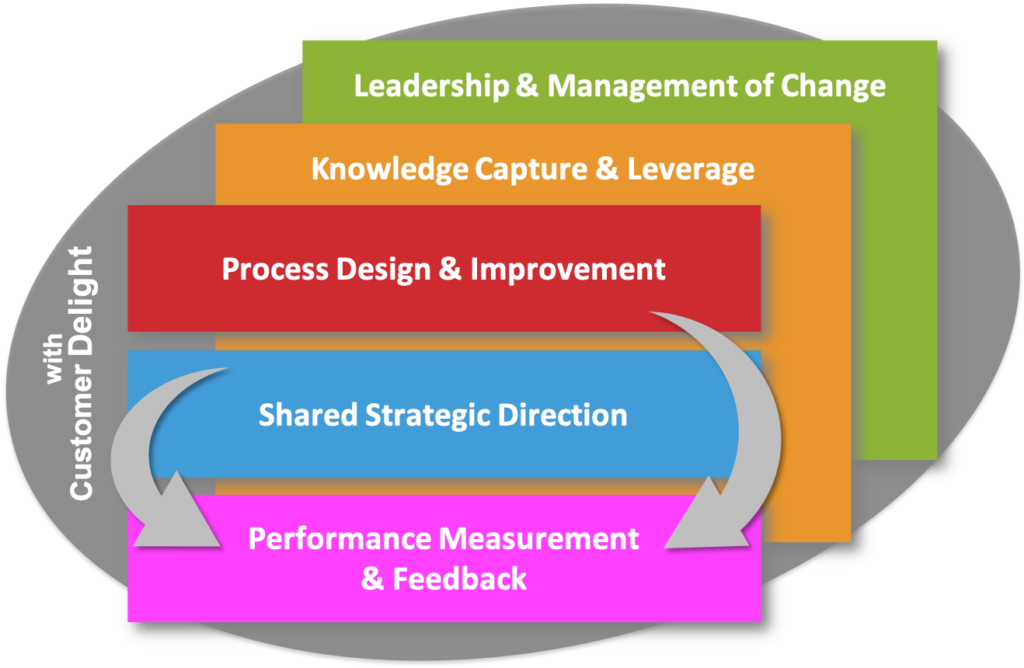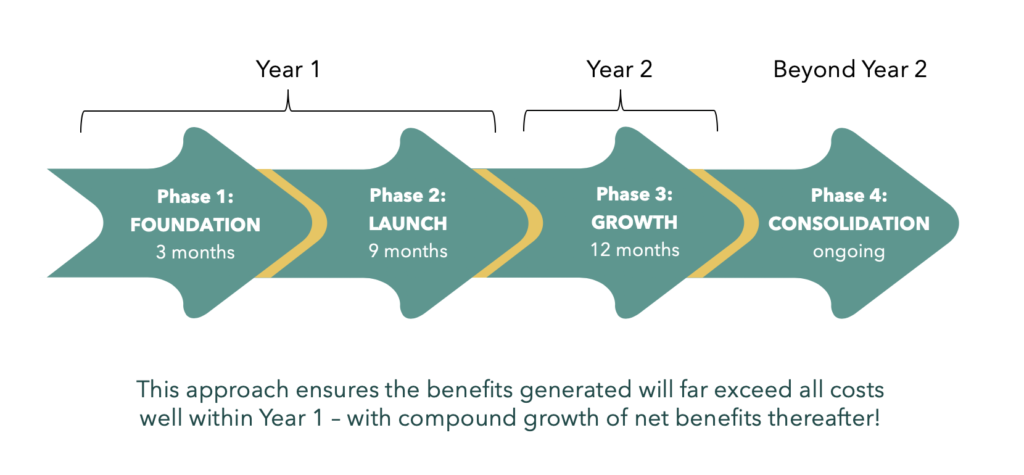The My Business Excellence (MBE) Framework is for any SME / SMB that wishes to become high performing in the shortest possible time. It comprises five Prerequisites for excellence, all driven by the need to ensure Customer Delight in everything. [Purchase a copy of the book: ‘GOING ALL IN – How To Implement Excellence In Your Business’ if you would like the comprehensive implementation roadmap.]

![]() Implementation Challenge
Implementation Challenge
How can you convert these five high level Prerequisites into concrete action?
Unfortunately, most business CEOs and their employees spend almost all their time working IN the business. To implement business excellence and reap the huge rewards, you and your colleagues need to work ON the business for some of the time. By following our MBE approach, the completed process improvement projects free up time, which allows you and your people to spend even more time working ON the business. This feedback loop makes things easier and easier.
So the hard part is to get started and build momentum.
The Four Phases of Implementation
The fast track to excellence requires four distinct implementation phases. The first three phases rapidly build the capability necessary for successful transformation of your business, and take place over the first two years. We help our customers execute these first three phases, during which substantial net benefits are realised – even within the first 12 months.

Phase 1: FOUNDATION (3 months)
The FOUNDATION phase is critical because it sets up the five Prerequisites for excellence ready for implementation and full integration in the subsequent phases.
The CEO must be fully committed and prepared to lead the charge. Furthermore, the CEO and other people in managerial roles need to have (or develop) a collective leadership style that empowers employees to work in small autonomous teams to get things done. If you have an ‘autocratic’ (does TO people) or ‘hero’ (does FOR people) leadership style and you are not prepared to change, then this approach is not for you or your business. The ideal leadership style is either ‘coach’ (does WITH people) or ‘enabler’ (does THROUGH people). Success with the MBE approach is dependent on getting all your people excited about and engaged in improving the business.
SMEs / SMBs that don’t have a formal and dynamic strategy have no chance of becoming excellent performers. Businesses that DO formulate a strategy but don’t follow through, ensuring key stakeholders take ownership and the proper infrastructure is in place, are likely to have their strategy gather dust. We enable you to do it differently. Developed during a 2-day workshop involving your management team, your strategic plan is depicted graphically on a single page. Depending on the perceived rate of change in your industry, the time horizon for your strategic plan may be 1,2,3 or 5 years out.
Strategy formulation is only part of what must happen during the 2-day strategic planning workshop. In addition, the business develops a 1-page process view of its entire business operation. All work in your business is done through its processes. The agreed 1-page Process Model depicts all the Key Business Processes (for external Customers) plus all the Key Support Processes (for internal Customers = your own employees). A willing part-time Process Manager is assigned to each one.
In all subsequent phases, the assigned Process Managers are accountable for deploying the strategic Objectives and for effecting local process improvements via measurable quarterly Projects. For this reason, special emphasis during the FOUNDATION phase is placed on training the nominated Process Managers in their crucial part-time role. Time is also devoted to finalising the right KPIs for each Objective and each Key Process.
Key Points
- Run your strategy workshop at the beginning of Phase 1 and develop a clear roadmap of what you’re going to achieve over the 2 year transition period, plus the steps to get there! NOTE: You will review your strategy and its KPIs every month, and you will formally roll the strategy forward once every year. Your strategy will need to change over time, but that’s no excuse not having one to guide your journey. The main deliverables of this strategy workshop are your 1-Page Process Model for Running Your Business and your 1-Page Strategy for Changing Your Business.
- Ensure your key people have ownership of the Key Processes within your business and understand their crucial roles as Process Managers.
- Make sure you have the right infrastructure for performance reporting, project management and knowledge management. Without it, you’re going to have to work much harder each month to measure your progress and document your process changes in the subsequent Phases.
- Get buy-in from all employees and the board if applicable. This is your shared strategic direction. Everyone must commit to and actively participate in its delivery.
- Finalise the set of KPIs for strategic Objectives and for all Key Processes.
Phase 2: LAUNCH (9 months)
During this LAUNCH Phase, the rubber hits the road. You begin to execute your Strategic Plan in full.
The Process Managers of your Key Support Processes are the main drivers of progress, backed up by the Process Managers of your Key Business Processes.
In this phase you’ll begin to build momentum and realise positive net benefits within just a few months. Efficiencies gained through quarterly Fast Process Improvement (FPI) projects will free up time for the participating staff so they can spend even more time working on the business, freeing up even more time. Exciting Stuff.
Importantly, the benefits generated by the end of Year 1 will be well in excess of all internal and external implementation costs.
Key Points
- Your Process Managers are the engine room for implementing business excellence. They need to be trained for success and held accountable by you, the CEO.
- Employees are trained in fast process improvement techniques.
- Throughout this LAUNCH Phase, your Objectives begin to be deployed via an increasing number of targeted, top-down quarterly Projects sponsored by a few of the Process Managers. Each Process Manager chooses and defines their quarterly Project(s) to best contribute to delivery of one strategic Objective.
- The average Benefit : Cost ratio for these quarterly Projects should exceed 10 : 1 and the efficiencies gained will help free up your company’s resources to make further improvements.
- Provided your business has more than 50 full time employees, you’ll trigger your first major Business Process Reengineering Project during this phase.
- Each month a Progress Review Meeting will occur to review the progress of each quarterly Project, Key Processes and their respective KPIs to ensure everything remains on track.
- Each quarter a Planning Meeting will occur to review the strategic Objectives and select new quarterly Projects to further progress your strategic Objectives.
- By means of a 1-day Strategic Planning Workshop held at the end of Year 1, your 1-page Strategic Plan will be formally reviewed and rolled forward to reflect any major changes required.
Phase 3: GROWTH (Year 2)
In this GROWTH phase, you will accelerate penetration of the knowledge and skills needed to implement the approach. Many more of your employees will become actively engaged with the same techniques already introduced in Phases 1 and 2. Your leaders will continue to nurture and empower their employees using these proven techniques.
Many experts estimate it takes years to instil a new culture, particularly in very large businesses. However, our MBE techniques designed for SMEs enable a culture of continuous improvement to be instilled much faster. By the end of Year 2, you will be well on your way because most of your employees will have been actively involved each quarter in improving the processes of the business and progressively achieving the strategic Objectives.
Key points
- Dependent on the number of Key Processes in the business, the number of quarterly Projects undertaken in this phase will be limited by the available people resources but certainly will be far greater than the number of projects completed in the preceding LAUNCH Phase.
- Your quarterly Projects will comprise a mixture of top-down strategy deployment projects selected by your Process Managers and bottom-up process improvement projects recommended by your employees at the coal face of operations and sponsored by their respective Process Manager.
- You will also undertake one or two large, top-down Business Process Reengineering Projects.
- By the end of this Phase, you will see a culture of continuous improvement beginning to flourish within your business as employees throughout your business take ownership of improvement initiatives.
- At the end of Year 2, your 1-page Strategic Plan will again be formally reviewed and rolled forward during a 1-day Strategic Planning Workshop to reflect any major changes required.
Phase 4: CONSOLIDATION (beyond Year 2)
This ongoing phase is about maintaining what you have and institutionalising the approach so that it becomes ‘Business As Usual’. You will continue to deploy your strategic Objectives via carefully chosen quarterly projects executed by small autonomous teams. Almost all your employees will have become actively engaged.
By the end of Year 2, you will be well on the way to being a high performing business with runs on the board. And you’re likely be regarded as a leader in your industry.
Overall cumulative Net Savings of at least 22.5% of this year’s Sales Revenue should accrue by rigorously following this approach.
Summary
Some might baulk at the 2-year timeframe outlined above. However, if you look at the results over those two years –
- Successfully executing your strategy
- Significant productivity gains through lots of Fast Process Improvement Projects, with an average ROI of at least 10 to 1.
- Massive productivity gains and new IT capabilities added through Process Reengineering
- A culture of continuous improvement
- Overall cumulative net savings over 5 years of at least 22.5% of this year’s Sales revenue. Forecast these savings for your business. For example, a business currently turning over say $50M per annum, will save at least $11.2M over the next 5 years with this implementation approach. This is too much for you or your shareholders to ignore.
Building a high performing business does not happen overnight, but with the systematic, step by step process outlined above and detailed in the book, you will get there. Read More>

